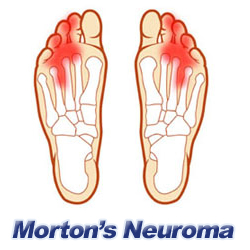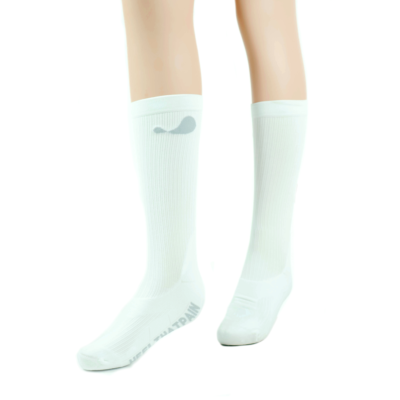Here at Heel That Pain, the majority of our free educational materials revolve around the condition known as Plantar Fasciitis. The hallmark symptom of this ailment is pain in one or both heels. Other areas of the foot can become compromised, however, and if your pain is centered in your forefoot near your third and fourth toes, you may have developed a completely different condition called Morton’s Neuroma. This easy-to-read article will acquaint you with the symptoms, causes and treatment options associated with Morton’s Neuroma and will enable you to begin diagnosing the pain you are currently experiencing.

What Are The Symptoms of Morton’s Neuroma?
Bear down with your weight on your foot. Would you describe your discomfort as aching, sharp, stinging or burning in the region of your third and fourth toes? Perhaps your toes feel like they are tingling or numb. It may also feel like you’re standing on a small foreign object, such as a pebble. The pain may radiate into the ball area and may lessen once you take your weight off the foot. All of these descriptions are common symptoms of Morton’s Neuroma.
What Causes The Symptoms Of Morton’s Neuroma?
It is believe that this condition develops as a result of an injury to nerves in the ball of the foot or to pressure or irritation of the toes. The affected nerve swells, causing pain and a mass of tissue may form around the nerve.
The name of this ailment sometimes causes undue concern; it’s important to understand that despite the inclusion of the word ‘neuroma’, Morton’s Neuroma does not involve a true tumor. Rather, it is simply a perineural fibroma – a formation of fibrous tissue surrounding a nerve in the metatarsal region. This is a non-cancerous condition, but symptoms should not be ignored if the pain in this toe and ball area of the foot persists for more than a few days.
-
 Compression Socks$22.95 – $82.62
Compression Socks$22.95 – $82.62 -
 High Arch Sole Seats$39.95
High Arch Sole Seats$39.95 -
 HTP Heel Seats (Pair)$24.95
HTP Heel Seats (Pair)$24.95
Who Is At Risk For Developing Morton’s Neuroma?
Adults of both genders and all ages can develop this ailment, but it is found in a disproportionately higher number of women rather than men. The culprit in such cases is the wearing of high heeled shoes that place undue strain, weight and pressure on the metatarsal area of the foot because of the unnatural position into which the foot is tilted. Shoes with narrow toes can also lead to development of Morton’s Neuroma because of the pressure they place on the cramped nerves and tissues.
For many years now, podiatrists have cited high heels and other forms of ill-fitting footwear as leading causes of multiple, serious syndromes involving the foot, as well as chronic disorders of the legs, hips and back. Wearing any type of shoe that does not adequately reflect and support your foot’s correct anatomical structure can sideline you with months or years of painful health problems.
Even if you wear excellent shoes, you may develop Morton’s Neuroma if you have a physical anomaly of the foot, such as hammer toes, high arches, flat feet or bunions. Participation in high-impact sports, such as running, can also increase the risk of developing this malady.
How Is Morton’s Neuroma Diagnosed?
Your doctor may order an X-ray, MRI or Ultrasound to diagnose your problem and to rule out other possible causes of your pain, such as a tumor, a bone fracture or the presence of another condition such as rheumatoid arthritis. In Morton’s Neuroma, your physician will typically be looking for a mass of painful tissue between your third and fourth toes, or simply for a sore spot in this location. Some patients report hearing a clicking sound in this region during the exam.
How Is Morton’s Neuroma Treated?
The treatment your physician recommends will be based on the severity of your symptoms. It is always best to try conservative, non-invasive methods first.
You can begin by purchasing new shoes that correctly align with the anatomical structure of the foot and offer toes plenty of room, and by implementing daily wear of specialized shoe inserts designed to reduce pressure on the affected nerve. Fascia-Bar treatments, as featured in Heel Seats and Gel Seats, comply with the foot’s structural needs, reduce pressure on the metatarsal region and increase arch and heel support. Many cases of Morton’s Neuroma can be resolved with new shoes and proper orthotic inserts.
If these conservative treatment options fail, your doctor may suggest steroid injections as an option for reducing pain. Always carefully weigh the risks and benefits of steroid use with your doctor.
Two types of surgery may also be considered in severe cases. Decompression surgery involves cutting away certain areas of the foot, such as ligaments, in order to relieve pressure on the nerves. Nerve removal surgery involves removal of the affected tissues in order to decrease pain. There are risks involved in these surgeries, including permanent loss of feeling in the foot and the possibility of regrowth of the neuroma. Most patients experience a positive outcome, but always discuss the risks of surgery with your physician.
What If Morton’s Neuroma Is Left Untreated?
If you develop this condition and do not seek to treat it via conservative options, it will likely worsen, making standing and walking acutely painful. The longer symptoms are ignored, the likelier you are to require more drastic treatments further down the road. Paying attention to symptoms is extremely important, in terms of getting an early diagnosis and implementing least-invasive options as soon as possible.
Your best preventative care against the development of Morton’s Neuroma lies in committing to purchase shoes that are designed with foot health, not fashion, in mind. Well-made footwear mimics the natural contours and elevation of the foot and has a roomy toe box. It’s also important to balance periods of activity with periods of rest and to eat a diet containing ample vitamins and minerals that support the health of nerves, ligaments and bones.




